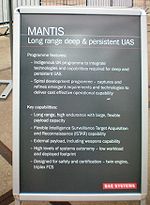- BAE Systems Mantis
-
Mantis Mock up of BAE Systems Mantis at Farnborough Airshow 2008 Role Remote controlled UAV Manufacturer BAE Systems First flight November 2009[1] Primary user United Kingdom The BAE Systems Mantis Unmanned Autonomous System Advanced Concept Technology Demonstrator is a British demonstrator programme for Unmanned Combat Air Vehicle (UCAV) technology. It is the world's first unmanned autonomous aircraft. The Mantis is a twin-engined turboprop-powered UCAV with a wingspan of approximately 22 m, broadly comparable to the MQ-9 Reaper. Other partners involved in Phase 1 of the Mantis programme include the UK Ministry of Defence, Rolls-Royce, QinetiQ, GE Aviation, L3 Wescam, Meggitt and Lola.
Contents
Design and development
Development of the Mantis started in late 2007, a mock-up being revealed at the 2008 Farnborough International Air Show. The Phase 1 Mantis vehicle is powered by two Rolls-Royce Model 250 turboprop engines, although this is likely to change in later variants. The Mantis is intended to have at least 24-hour endurance and is an autonomous vehicle, able to pilot itself and to plot its own course, communicating with personnel on the ground regarding its observations.[2]
Phase 1 is intended to demonstrate BAE Systems' rapid prototyping capabilities and will focus on the evaluation of autonomous control systems. Later phases may evaluate civilian applications, armed variants and sensor packages.
The large dome on the front, reminiscent of a pilot's canopy, actually contains an upward facing satellite communications system.
The prototype first flew on 21 October 2009 at Woomera Test Range in South Australia.[1]
Specifications
See also
- Related development
- Related lists
References
- ^ a b Craig Hoyle (13 November 2009). "UK's Mantis UAV demonstrator makes first flights". Flight International. http://www.flightglobal.com/articles/2009/11/13/334804/picture-uks-mantis-uav-demonstrator-makes-first-flights.html. Retrieved 2009-11-14.
- ^ Mantis, gallery of future drones, Popular Science, March 2010.
- "BAE Systems and UK MOD Announce Mantis UAS Demonstrator Programme". www.baesystems.com. 2008-07-14. http://www.baesystems.com/Sites/FarnboroughInternationalAirshow2008/Newsroom/autoGen_10861413322.html. Retrieved 2008-07-17.[dead link]
- Chuter, Andrew (2008-07-14). "BAE To Build Knowledge Base With UAV". DefenseNews. http://www.defensenews.com/osd_story.php?sh=VSDF&i=3625470&c=EUR&s=AIR. Retrieved 2008-07-17.
External links
British Aerospace and BAE Systems aircraft Combat aircraft Harrier • Harrier II • Jaguar • Sea Harrier • Tornado • Tornado ADV • Typhoon
Patrol and surveillance Nimrod • Nimrod AEW3 • Nimrod MRA4
Trainers Airliners/Transports ATP • BAe 125 • BAe 146 • Concorde • Jetstream 31/32 • Jetstream 41 • Jetstream 61 • One-Eleven
Drones (UAVs) Combat drones (UCAVs) Fury • Taranis
Development/Concept aircraft Lists relating to aviation General Aircraft (manufacturers) · Aircraft engines (manufacturers) · Airlines (defunct) · Airports · Civil authorities · Museums · Registration prefixes · Rotorcraft (manufacturers) · TimelineMilitary Accidents/incidents Records Categories:- BAE Systems
- Unmanned aerial vehicles of the United Kingdom
- Medium-Altitude Long-Endurance unmanned aerial vehicles
- Airborne military robots
- Pusher aircraft
- Twin-engined aircraft
Wikimedia Foundation. 2010.


